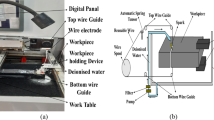Abstract
Silicon carbide particulates-reinforced polymer matrix composites have gained a reputation among composite materials due to their excellent mechanical properties. But these materials are categorized as hard to machine materials due to hardness and the abrasive nature of reinforcing particulates. For that purpose, it becomes necessary to develop a machining method which can be extensively used for machining of these types of materials. In this paper, an attempt has been made to optimize machining parameters of electrochemical discharge drilling process through response surface methodology. The experimentation was planned as per Box–Behnken design. Three process parameters, i.e. electrolytic concentration, voltage and inter-electrode gap were analyzed to explore their influence on output quality characteristics. The parameters voltage and inter-electrode gap are identified as most significant parameters for material removal rate and over cut, respectively. The surface plots were generated to study the effect of machining parameters as well as their interaction on output quality characteristics. The morphology of drilled hole was analyzed by scanning electron microscopy. A novel technique of measuring adjusted delamination factor (Fda) was adopted to analyze surface quality of machined zone. The analyzed results indicate that irregular damage pattern induced during drilling of composites can be effectively measured using adjusted delamination factor.










Similar content being viewed by others
References
Antil P, Singh S, Manna A (2017a) Glass fibers/SiCp reinforced epoxy composites: effect of environmental conditions. J Compos Mater 52(9):1253–1264
Antil P, Singh S, Manna A (2017b) Electrochemical discharge drilling of SiC reinforced polymer matrix composite using Taguchi’s grey relational analysis. Arab J Sci Eng 43(3):1257–1266
Antil P, Singh S, Manna A (2018a) Analysis on effect of electroless coated SiCp on mechanical properties of polymer matrix composites. Part Sci Technol. https://doi.org/10.1080/02726351.2018.1444691
Antil P, Singh S, Manna A (2018b) SiCp/glass fibers reinforced epoxy composites: wear and erosion behavior. Indian J Eng Mater Sci 25(2):122–130
Asgarshamshi A, Hajilouy-Benisi A, Assempour A, Pourfarzaneh H (2016) Multipoint optimization of lean, and sweep angles for stator and rotor blades of an axial turbine. Iran J Sci Technol Trans Mech Eng 1:1–13
Benyounis KY, Olabi AG, Hashm MSJ (2005) Optimizing the laser welded butt joints of medium carbon steel using RSM. J Mater Process Technol 164–165:986–989
Bhattacharyya B, Munda J (2003) Experimental investigation on the influence of electrochemical machining parameters on machining rate and accuracy in micromachining domain. Int J Mach Tools Manuf 43:1301–1310
Davim JP (2003) Study of drilling of metal matrix composites based on the Taguchi techniques. J Mater Process Tech 132:250–254
Davim JP, Rubio JC, Abra AM (2007a) Delamination assessment after drilling medium-density fibre board (MDF) by digital image analysis. Holzforschung 61:294–300
Davim JP, Rubio JC, Abra AM (2007b) A novel approach based on digital image analysis to evaluate the delamination factor after drilling composite laminates. Compos Sci Technol 67:1939–1945
Davim JP, Gaitonde VN, Karnik SR (2008) An investigative study of delamination in drilling of medium density fibreboard (MDF) using response surface models. Int J Adv Manuf Technol 37(1):49–57
Goud M, Sharma AK, Jawalkar C (2016) A review on material removal mechanism in electrochemical discharge machining (ECDM) and possibilities to enhance the material removal rate. Precis Eng 45:1–17
Hashmi KH, Zakria G, Raza MB, Khali S (2016) Optimization of process parameters for high speed machining of Ti–6Al–4V using response surface methodology. Int J Adv Manuf Technol 85:1847–1856
Jain VK, Dixit PM, Pandey PM (1999) On the analysis of the electrochemical spark machining Process. Int J Mach Tools Manuf 39:165–186
Kumar S, Batish A, Singh R, Singh TP (2014) A hybrid Taguchi-artificial neural network approach to predict surface roughness during electric discharge machining of titanium alloys. J Mech Sci Technol 28(7):2831–2844
Malik A, Manna A (2016) An experimental investigation on developed WECSM during micro slicing of e-glass fibre epoxy composite. Int J Adv Manuf Technol 85:2097–2106
Manna A (2013) Multi response optimization of machining parameters during drilling LM6Mg15SiC–Al–MMC based on grey relational analysis. Int J Mach Mach Mater 14(3):275–294
Manna A, Narang V (2012) An experimental investigation during micro machining of e-glass-fibre epoxy composite on developed by ECSM setup. Int J Manuf Mater Mech Eng 2(2):46–60
Manshadi MD, Jamalinasab M (2017) Optimizing a two element wing model with morphing flap by means of the response surface method. Iran J Sci Technol Trans Mech Eng 41:343
Montgomery DC (1997) Design and analysis of experiments, 4th edn. Wiley, Berlin
Neseli S, Yaldız S, Turkeş E (2011) Optimization of tool geometry parameters for turning operations based on the response surface methodology. Measurement 44(3):580–587
Rahamathullah I, Shunmugam MS (2014) Mechanistic approach for prediction of forces in micro-drilling of plain and glass-reinforced epoxy sheets. Int J Adv Manuf Technol 75:1177–1187
Sathishkumar TP, Satheeshkumar S, Naveen J (2014) Glass fiber-reinforced polymer composites—a review. J Reinf Plast Compos 33(13):1258–1275
Singh S (2016) Effect of modified drill point geometry on drilling quality characteristics of metal matrix composite (MMCs). J Mech Sci Technol 30(6):2691–2698
Singh S, Singh I, Dvivedi A (2013) Multi objective optimization in drilling of Al6063/10% SiC metal matrix composite based on grey relational analysis. J Eng Manuf 227(12):1767–1776
Author information
Authors and Affiliations
Corresponding author
Rights and permissions
About this article
Cite this article
Antil, P., Singh, S. & Manna, A. Experimental Investigation During Electrochemical Discharge Machining (ECDM) of Hybrid Polymer Matrix Composites. Iran J Sci Technol Trans Mech Eng 44, 813–824 (2020). https://doi.org/10.1007/s40997-019-00280-5
Received:
Accepted:
Published:
Issue Date:
DOI: https://doi.org/10.1007/s40997-019-00280-5




